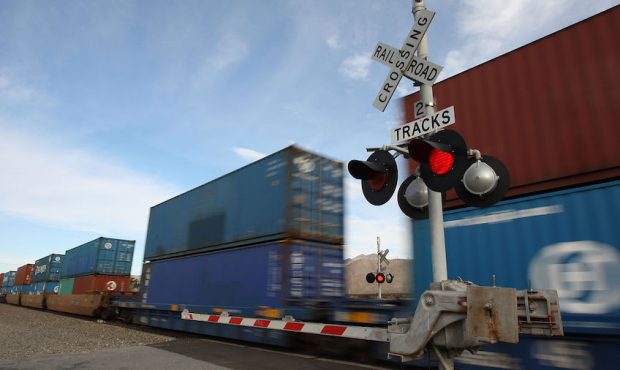Long Beach port sending containers to Utah by train to ease congestion
Oct 28, 2021, 2:04 PM

FILE (Photo by David McNew/Getty Images)
(Photo by David McNew/Getty Images)
SALT LAKE CITY — Officials with the Port of Long Beach, Utah Inland Port Authority and Union Pacific have announced a partnership to begin shipping containers to Salt Lake City by train to ease congestion at the West Coast port.
All cargo destined for the Intermountain West will be shipped to Utah by train before being distributed to its final destination by truck, according to a press release from Union Pacific.
“Much of this cargo traditionally moves to Utah, Colorado, Nevada, and Idaho by truck, and thus must be removed from the port terminals one container at a time. Reengaging this direct rail service will allow removal of blocks of containers at a time,” said executive directors Mario Cordero of the Port of Long Beach and Jack Hedge of the Utah Inland Port Authority.
An estimated $24 billion in goods is currently sitting outside ports in Los Angeles and Long Beach, which account for 40% of all shipping containers entering the United States.
Long Beach crews have been working 24/7 for several weeks now, and there are plans to convert the Port of Los Angeles to 24/7 operations. However, once ships are able to dock and unload, shipping containers have still dwelled at the ports for days.
That’s where officials say this initiative will come into play, relieving short-term congestion and potentially shifting long-term services to Utah.
“Union Pacific is pleased to support customers in the region,” said Hasan Hyder, general director of intermodal at Union Pacific. “Our Salt Lake City facilities offer a perfect relief valve for some of the current port congestion and open a new world of services for companies across the region.”
Officials said millions of containers are imported to and exported from the Intermountain West each year, but only 10% of it moves by rail.
This initiative “aims to provide consistent, reliable movement of cargo on rail” and reduce shipment delays by utilizing existing rail systems at the Port of Long Beach, which the nation’s second-busiest seaport.
“A direct connection to Utah links two critical points in the supply chain and immediately reduces pressure on terminal storage, gates, chassis, and the local drayage community on the coast,” Cordero said. “Not only is this a more efficient service for importers in the Intermountain West, but it’s also a major step forward for exporters from the region.”
Union Pacific said loading 100 rail cars takes an estimated 300 trucks off the road. An analysis by the Association of American Railroads concluded railroads are, on average, four times more fuel-efficient than trucks and moving freight by rail instead of truck lowers greenhouse gas emissions by 75%.
“Converting road into rail cargo has many benefits and is part of our ongoing drive to reduce impacts associated with cargo movement,” Hedge said. “In addition to providing enhanced efficiency for regional importers and exporters, this service will reduce truck traffic across Utah and positively impact our local air quality and freeway congestion issues.”
The Utah Inland Port Authority also announced the Intelligent Crossroads Network, “a private 5G and artificial intelligence network built in partnership with QuayChain Technologies that will allow cargo tracking, monitoring and planning, and even greater efficiencies for users throughout the corridor connecting Long Beach and Utah.”
“Both (the Utah Inland Port Authority) and (Port of Long Beach) agree that current issues in the supply chain reveal the urgent need for new ways of doing business and solutions that combine existing resources and new technologies,” Hedge said. “The ICN allows for the most digitally connected logistics experience possible in the supply chain.”















